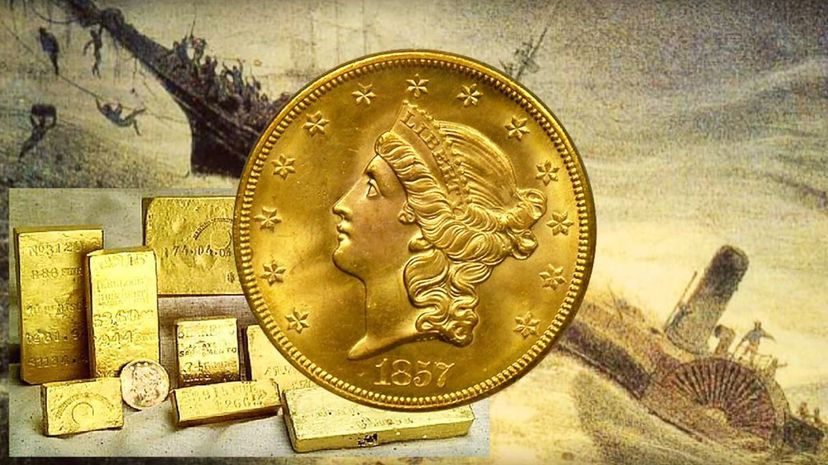
As a mail steamer called the S.S. Central America chugged along the Atlantic coast In 1857, bound for New York, it was hit by a hurricane off the coast of South Carolina. More than 400 people died, 38,000 pieces of mail were lost, and an estimated 21 tons of gold — a huge portion of the national wealth recently prospected in the California Gold Rush — plunged to the bottom of the Atlantic after a sinking that took upwards of 40 hours. The shipwreck took with it so much commercial gold, and so many newly-rich gold prospectors, that the incident triggered a downturn in the U.S. economy that wasn't righted until after the Civil War.
And you'd better believe people tried to find and retrieve the "Ship of Gold," as it became known. For 130 years, treasure hunters scoured shallow waters of the Atlantic off the coast of the Carolinas for signs of it, but nobody had any luck even estimating the location of the wrecked ship. Nobody, that is, until 1988, when an Ohio engineer named Tommy Thompson found the shipwreck — with relative ease, apparently. Convincing 160 investors (mostly from his home state of Ohio) to give him almost $13 million to invent a robotic device to find and retrieve the loot from beneath 8,000 feet (2,438 meters) of open ocean, Thompson became a hero.
Advertisement
Fast forward 28 years, and Tommy Thompson, once celebrated as the genius who recovered a significant national treasure, sits in an Ohio jail cell, refusing (or unable) to tell the authorities where he hid the gold.
A Sticky Situation
In case you're interested, when an enormous treasure is discovered, it's no simple matter parsing out who it belongs to. When Thompson and his crew first discovered the wreckage of the Central America, legal troubles arose almost immediately. Insurance companies claiming to have insured the ship in the 1800's, for instance, immediately sued for a cut of the profits. In 2000, when Thompson sold a portion of the first 3-ton haul for an estimated $50 million, the investors who had funded the expedition sued him for their share of the gold (they haven't seen an ingot of it yet).
Then, in 2012, when Thompson was called into court yet again, he didn't show up. A warrant was issued for his arrest, but when the police tried to find him, they found instead that he had disappeared completely. And catching him and his girlfriend Alison Antekeier was difficult; not only is Thompson smart, he had "almost limitless resources and approximately a 10-year head start," Peter Tobin, U.S. Marshal for the Southern District of Ohio, told the Chicago Tribune.
When it came to disappearing, Thompson and Antekeier did everything by the book, literally. Specifically it's a book called "How to Be Invisible," which was found in Thompson's rented Florida mansion (paid for with damp cash, according to the landlord) that they fled in 2012, leaving behind nothing but some boxes of papers, several disposable cell phones, and money straps marked for amounts of $10,000. After a manhunt spanning two years, police found Thompson and Antekeier living in a $200-per-night hotel near West Palm Beach. Although the police celebrated the capture, it turns out they weren't much closer to finding the treasure. Want even more background? Check out this Slate video on the incident:
Where Are We Now?
Thompson is currently sitting in an Ohio jail cell, incurring a $1,000-per-day fine. That's on top of the $250,000 stemming from a criminal contempt charge and 208 hours of community service he was slapped with for not showing up in court in 2012. And while Thompson sits in jail, the wreckage of the S.S. Central America remains at the bottom of the ocean. Subsequent expeditions have turned up even more treasure, like on a 2014 foray by the recovery outfit Odyssey Marine Exploration.
But although he remembers a lot about his discovery, Thompson says he can't remember where he hid the remaining gold he didn't sell. He's even been given back his papers confiscated in 2012 so that he can try to put together the story, but he's not budging. An Ohio court has ruled he is faking his memory problems, but the fact remains: for now, most of the treasure from the SS Central America is lost — again.
Advertisement